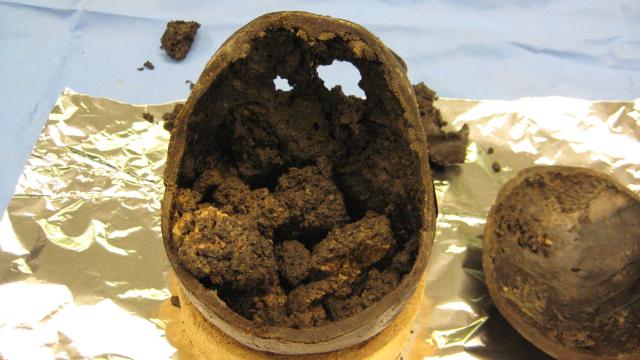An Iron Age human skull found in 2008 contained an unprecedented amount of preserved brain material, a discovery that has confounded scientists for over a decade. New research finally explains why this brain resisted decay for thousands of years.
The skull containing the Heslington brain, as it’s called, was found in a soggy mud pit near the British village of Heslington. The skull dates back some 2,600 years ago to the British Iron Age, and it belonged to a middle-aged man who was decapitated, according to research done a few years ago. His head was buried in soil immediately afterward. Over time, the spot became a soggy, mud-filled bog.
When this skull was first uncovered, the archaeologists were shocked to find a generous amount of dark brain tissue inside, which was described as having the consistency of tofu. It’s considered to be the most well-preserved brain dating back to ancient times. Such a thing is rare, if not completely unheard of, since brain matter degrades exceptionally quickly due to its high fat content. This is due to a process known as autolysis, in which the body’s enzymes destroy cells and tissues inside the brain.
Scientists have been at a loss to explain why the Heslington brain avoided autolysis, as it doesn’t appear to have been embalmed or specially prepared for preservation prior to burial. What’s more, no other traces of biological material, such as hair, were found alongside the skull, hinting that something other than the wet, oxygen-poor environment was responsible for the preservation.
New research published in the Journal of the Royal Society Interface is finally providing an explanation. First author Axel Petzold from University College London and his colleagues studied samples of the brain from a molecular perspective, with a particular emphasis placed on the proteins—that special stuff that comprises and binds bodily tissue.
In a process that required a full year of lab work, the researchers carefully documented how proteins unfolded in the Heslington brain. In total, the scientists identified over 800 proteins, many of which still looked normal. Some of the proteins were still hardy enough to exhibit an immune response, as shown in mice.
Importantly, the proteins had become folded into tightly packed and stable “aggregates,” according to the new paper. This configuration made the proteins more durable and capable of staving off the decay associated with death. This special aggregate formation “permits for the preservation of brain proteins for millennia,” according to the study.
Key to these formations are two types of brain fibres, both of which were found to reside in the Heslington brain: neurofilaments and glial fibrillary acidic proteins (GFAP). Together, these structures have worked over time as a scaffold to keep the Heslington brain matter intact.
Petzold and his colleagues speculate that, around three months after the man died, enzymes that would normally ravage the brain were shut down. And indeed, lab experiments pointed to this possibility, showing that, in the absence of autolysis, it takes about three months for proteins to fold themselves into the the tightly wound aggregates.
A pressing question remained, however: What deactivated the enzymes?
The authors believe an acidic fluid somehow got into the brain, either before or after the man died. Forensic evidence on the skull suggests he was either struck in the head or hanged prior to decapitation, which may have something to do with it. So, while a big part of this mystery has been solved, this lingering question still needs to be sorted out, namely the origin of the acidic fluid, should that be the case. Another possibility not ruled out in the study is that the man suffered from some unknown disease that contributed to the preservation.
That said, the acidic fluid theory is bolstered by the discovery of neurofilament proteins in the outer, grey matter portions of the Heslington brain. That’s weird, as neurofilament proteins are typically found in the inner, white matter portions of the brain. The authors suspect that autolysis was first shut down in the outer portions of the brain, possibly due to the mysterious introduction of the acidic fluid.
[referenced url=” thumb=” title=” excerpt=”]
Importantly, there are other factors to consider as well, as a kind of perfect storm was required to produce this unusual preservation. The head was buried in a cold, fine-grained sediment, which created an oxygen-free, bacteria-unfriendly environment, contributing greatly to the preservation. It also helped that the skull was buried so quickly after decapitation and that the area became especially soggy over time.
A lot of things had to happen for this brain to remain in such a well-preserved state for thousands of years. Little wonder it’s the only one of its kind.
